|
Category Archives: Blog
A NEW BOOK (FINALLY!)
I’m pleased to announce the publication of my new book Up North in Michigan: A Portrait of Place in Four Seasons (University of Michigan Press, hardcover, 186 pages, $24.95). This one’s been in progress for a number of years and finally came together during the pandemic. I’ll always remember it as my Covid book—the one that kept me on an even keel during the stormy days of 2020-21.
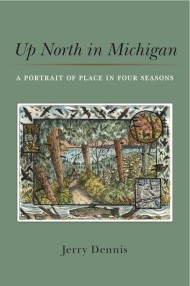
The cover and interior illustrations are by the incomparable Glenn Wolff. This is the tenth book we’ve done together, with, I hope, many more to come. My life was enriched beyond measure the day Glenn and I met for the first time at Stacey’s Restaurant in 1988. By the end of that lunch we had outlined three books. Now, 34 years later, we have at least ten more lined up on our to-do list. It’s a rich tapestry, as Glenn often says.
One change this time around: In my ongoing quest to simplify my life I’m no longer selling books directly, so if you want autographed or inscribed copies (of any of my titles) please call or email Horizon Books. I’ll be stopping there every week or so to sign books and would be happy to personalize them in any way you wish.
Or, if autographs aren’t important to you, University of Michigan Press is offering a generous discount and free shipping if you order directly from them. Follow this link.
Another change: I’ve decided not to do many public appearances this year—and, perhaps, any other year (again, that need to simplify), but I will be launching the new book this Saturday at 1:00 at Horizon in Traverse City. Meet me at the fireplace, where I’ll discuss and read from the book starting at 1:00 and will hang around to sign books until 3:00. I hope you can drop by.
IT’S A NEW, NEW YEAR
“Doing okay,” is what most of my family and friends say whenever I ask. And none of us forgets that if you’re okay you’re one of the fortunate ones.But even those of us who have stayed healthy and not lost our jobs, homes, or loved ones have faced extraordinary challenges. If there’s been a time this century when everyone in the nation—everyone on the planet!—should come together to battle a common enemy, it is during these past eleven months.
Instead, of course, we’ve been divided by fear, anger, confusion, depression, fatigue, hopelessness, money worries, and a constant low-level anxiety verging on despair—all arriving and departing at unpredictable moments, day after day for all these months. No wonder we’ve been drinking more than usual.
And now? A week after an inspiring inauguration ceremony and two weeks since the insurrection at the Capital, there are reasons to be hopeful. I know there are, my head tells me so, but my heart isn’t convinced. Poor thing doesn’t want to get broken again. But I’m giving it some time. I’m pretty sure it’ll come around.
One consequence of the pandemic that Gail and I didn’t expect is to have more free time than we know what to do with. I never thought I’d say that. Here’s an example: I found Gail the other day on her hands and knees scrubbing the grooves in our brass door sill with an old toothbrush. And the next day I came into the living room and discovered her at the coffee table snapping vitamin tablets in half because they were too big to easily swallow. But the cut edges were sharp and hurt her throat so she was filing the edges smooth with a fingernail file. She had neat piles of filed and unfiled tablets before her and a little heap of vitamin dust between them.
We laughed about that. We’ve been surprised at how much we’ve been laughing lately. How can that be in these very unhumorous times?
Maybe we’re a little desperate to find something funny. Last week I was looking through a catalog (that’s how bored I was) and said to Gail, “Someday I want to get a down duvet for the bed.” Except I pronounced it “DUV-it” because I’m a hick. Gail started laughing, told me how to pronounce the word, then I was laughing too. All the rest of the day, every time one of us said “duv-it” we laughed all over again.
I can almost always make Gail laugh with potty humor. It might be one of the keys to our long and happy marriage. A couple nights later we were watching a cooking show on tv and the chef said, “Be sure to scrape up the sticky bits on the bottom of the pan, that’s where all the flavor is.” I said, “Eew. I think I have sticky bits in my underwear,” and Gail lost it. When she caught her breath, she said, “No duv-it for you, then.” And we both cracked up.
I know. You kinda had to be there. But the point is, laugh every chance you get.
Time Marches on, a Sad Loss, I’m Wearing My Editor Hat Again, and Reader’s Block Ends.
IT’S BEEN A MILD WINTER so far here in northern Michigan. We’re in “deep winter,” about midway between the fall and spring equinoxes, when we usually have temperatures in the teens and lower 20s and there should be a couple feet of snow on the ground. In fits of whimsy I’ve sometimes imagined (in The Windward Shore, for example) that this is a time when time slows, even stops.
But not this year. The ground is nearly bare now and the temperature has been 10 degrees above normal most days and nights since the middle of January. And time, alas, is hurtling along at its usual pace. We’ve been robbed.
No need to go into much detail, but I was happy to see 2019 end. We lost my dad in August, after a long illness, but I was fortunate to be at his side in the final months and weeks. That loss coupled with a flurry of lesser misfortunes (funny how they pile on like that) turned the year into an extended brush fire. My writing work got pushed aside, but I learned some new tricks with extinguishers and garden hoses.
The only significant work I did all year was consulting with other writers and editing their books. It was pure pleasure. I’ve always known that editing utilizes a different part of the brain than composing, but it turns out it works even when the creative function shuts down. I’d like to do more of it this year, so if you have a manuscript that needs doctoring, or you’d like some advice on how to jump-start a stalled project or get a finished one published, or you just need an objective reader who can tell you if you’re on the right track, I’m available and ready to work. And if you’re ready to take the leap into self-publishing, Gail is happily at work on custom book design and production. She has 30 years experience designing books in every format for clients ranging from one-book authors to the major New York publishers. Contact me at jcdennis@charter.net and we can talk.
Grief, as you probably know, is strange. During the six months before and after my dad’s death, reading failed me. I couldn’t concentrate; my eyes kept sliding off the page. Not only did I have writer’s block, I had reader’s block. It’s the first time I can remember that happening. Always before when I opened a book or magazine I could count on being carried away. Then, around January 1, whatever was broken healed enough to send me on a reading binge.
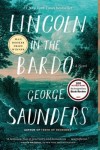 It began with the astonishing novel Lincoln in the Bardo by George Saunders. I’ve admired Saunders’ short fiction since his inaugural collection 20 or so years ago (CivilWarLand in Bad Decline), but I wasn’t prepared for this, his first novel. It’s like nothing I’ve ever read, and I’ve studied the modernists, postmodernists, and various pseudo- meta- and post-post-modernists my entire reading life. Saunders’ novel is like no other I’ve read. It’s deeply imagined, constantly surprising, powerful, heartbreaking, and beautiful. I finished it sobbing. Couldn’t stop thinking about for days, so I sat down and read it again. And I liked it even better the second time.
It began with the astonishing novel Lincoln in the Bardo by George Saunders. I’ve admired Saunders’ short fiction since his inaugural collection 20 or so years ago (CivilWarLand in Bad Decline), but I wasn’t prepared for this, his first novel. It’s like nothing I’ve ever read, and I’ve studied the modernists, postmodernists, and various pseudo- meta- and post-post-modernists my entire reading life. Saunders’ novel is like no other I’ve read. It’s deeply imagined, constantly surprising, powerful, heartbreaking, and beautiful. I finished it sobbing. Couldn’t stop thinking about for days, so I sat down and read it again. And I liked it even better the second time.
Another novel I read with great pleasure is Annie Proulx’s latest, Barkskins. It’s ambitious: A  700-page multi-generational saga of the North American fur and timber industries from the 17th through the 20th centuries. It works on many levels: a carefully researched history of resource exploitation. An expose of injustices against Native Americans. A story of family dynamics and the way good and bad decisions reverberate through the generations. It’s a smart and complex page-turner. And of course, being Proulx, the writing is muscular, precise, and vivid.
700-page multi-generational saga of the North American fur and timber industries from the 17th through the 20th centuries. It works on many levels: a carefully researched history of resource exploitation. An expose of injustices against Native Americans. A story of family dynamics and the way good and bad decisions reverberate through the generations. It’s a smart and complex page-turner. And of course, being Proulx, the writing is muscular, precise, and vivid.
I’ve never been much of a fan of crime fiction but this winter I’ve decided to give it a go. My friend Jim Ekdahl in L’Anse, where they do some serious winter reading) suggested I give Scandinavian-noir another try (I was lukewarm about the Girl With the Dragon Tattoo series; those Swedes sure drink a lot of coffee), so I’ve been reading Jo Nesbo’s Harry Hole novels. I’m up to #4 in the series, and have enjoyed them well enough to keep going. Nesbo constructs believable, compelling plots populated by strong characters. I’ll probably stick with him for a few more books, at least.
I was more taken by the disturbingly believable novel about police corruption in New York City, The Force by Don Winslow. His characters are three-dimensional, the story is as complex and messy as life itself, and the writing is tight. I couldn’t put it down. I especially enjoyed the stories the cops told one another. For this son and brother-in-law of cops they rang true and were sometimes laugh-out-loud funny.
 A chance encounter at the new Peninsula Library carried me away to the Missouri Ozarks. Winter’s Bone by Daniel Woodrell had me by the throat with the first sentence and didn’t let go until the last word. Superb story-telling, luscious prose, and original and unforgettable characters make this a close second to Lincoln in the Bardo as my favorite read of the last year. At the center of the story is one the most original female protagonists in American literature. Jennifer Lawrence received acclaim for playing the role in the movie version, which I haven’t seen. I know she’s a fine actress, but I’d be surprised if she did justice to the character and personality of Ree Dolly. I doubt anybody could. Next up for me will be all of Woodrell’s novels.
A chance encounter at the new Peninsula Library carried me away to the Missouri Ozarks. Winter’s Bone by Daniel Woodrell had me by the throat with the first sentence and didn’t let go until the last word. Superb story-telling, luscious prose, and original and unforgettable characters make this a close second to Lincoln in the Bardo as my favorite read of the last year. At the center of the story is one the most original female protagonists in American literature. Jennifer Lawrence received acclaim for playing the role in the movie version, which I haven’t seen. I know she’s a fine actress, but I’d be surprised if she did justice to the character and personality of Ree Dolly. I doubt anybody could. Next up for me will be all of Woodrell’s novels.
Okay, this has gotten out of hand. I’m like a guy stranded on a tropical island for a year who is suddenly rescued: Can’t shut him up. So I’ll end with some other peoples’ words that helped during the past year:
“There is so much Everything/that Nothing is hidden quite nicely.” —Wislawa Szymborska, from her poem “Reality Demands”
“Art is how we keep the truth from destroying us.” —Nietzsche
“Whatever book or sentence will bear to be read twice, we may be sure was thought twice.—Thoreau, Journals
“The poet must not avert his eyes.” —Werner Herzog (Brick interview, Winter 2009)
“Lassitude in the heart puts lassitude on the page.” —Mary Oliver, Long Life
“…and he said it was good that God kept the truths of life from the young as they were starting out or else they’d have no heart to start at all.” —Cormac McCarthy, All the Pretty Horses
“Enough of this complaining and groaning and ape-like chatter.” —Marcus Aurelius, Meditations
“One should put away hope, and concentrate on joy.” —Spinoza

- The Peninsula Township Library
Lake Michigan in Winter
(January, Cathead Point, near the tip of Michigan’s Leelanau Peninsula)
IT CHANGES EVERY MOMENT. It’s a thousand lakes, changing faces with every shift in wind and light – flurried by offshore wind, white-capped in squalls, colored flannel gray or pearl white or stormy black beneath the winter clouds, a dozen blues when the sky is blue.
There’s a contemporary Japanese poet who writes a diary on a slab of stone instead of paper, with water instead of ink. He writes a word, and a moment later it evaporates. This, he suggests, is the true record of a life.
*
We go to the shore in search of elemental things. Probably it’s just coincidence that the elemental things we find there—sand, sun, wind, and waves—correspond exactly to the four elements of the ancient Greeks and Hindus—earth, fire, air, and water. More to the point is that we need elemental things to keep our primitive senses in working condition. We need periodically to look, listen, scent, taste, and feel our way through the world, if only for the relief of not having to think our way through.
It’s not always an easy task. Time coats us in natural increase, accruing layers as if we were snowballs rolling down a hill. Jobs, families, friends, houses, cars, dogs, our health– just maintaining it all is full-time work. Add the bulging files of information, the gunnysacks of mistakes and the duffels of misjudgments and the barrow-loads of memories, habits, regrets, opinions, prejudices, principles, laws, and codes collected in a lifetime, and you can see the problem. We carry as much as we can, and the rest we stack around us until all our routes to the outside are blocked. Even when we find our way out we’re wearing too many layers of tuxedoes and zoot suits and cardigans, Icelandic woolens, parkas, longjohns, thermal socks, etc. We’re strong but we grow weary of lugging that Collyer-brothers’ accumulation everywhere we go. We bend beneath the load, our backs about to break, groaning as we push our heaped-up grocery carts through the streets.
It’s too much. Now and then we need to strip down to the naked flame at our core so we can remember what it feels like to be alive. Most of what we carry is baggage anyway—just adornment and vanity, ballast and deadweight. It’s the crap the pioneers threw out along the Oregon Trail.
*
After lunch I walked to the crest of the dune and looked out at the lake. Even from that small elevation, maybe fifty feet, the water’s clarity was startling. From a boat, on a day like this, with the sun overhead, you can lean over the side and see boulders on the bottom thirty feet down.
The pale shallows stepped into blue depths. The offshore sandbars were there, a hundred yards apart, each deeper than the one before, with bands of increasingly darker blue between them. Beyond the last bar a steep drop-off into very deep water turned the water midnight blue.
Lake Michigan. My lake, I often think, because I grew up near it and because so many in my family settled along its shores. So much water, in a body so large they say that the Netherlands could fit inside, with enough room left over for several New England states. It is the second largest of the Great Lakes in volume, and third, after Superior and Huron, in surface area. It is the only one of the five to be contained entirely within the United States.
Most of the 1,640 miles of shore is sandy. Some of that shore, especially around the southern end, through Indiana and Illinois, is lined with industry. Around the top of the lake in Wisconsin and Michigan are limestone bluffs and rocky strands. But most of the rest is blond sand beaches that are among the loveliest in North America. Wind, waves, and ice have shoved that sand into the most extensive network of freshwater dunes on the planet. They reach their apogee about thirty miles south of Cathead Point at Sleeping Bear Dunes —the most beautiful place in America, according to “Good Morning, America,” and I don’t disagree—but they extend nearly unbroken for three hundred miles along the eastern and southern shores of the lake, from northern Michigan nearly to Chicago. A few scattered dunes are found also along the Wisconsin shore and at the top of the lake, in the Upper Peninsula of Michigan, but they lack the dimensions of those that face the prevailing winds.
A friend who lives part of every year in the West once told me that Lake Michigan plays the same role in the Midwest that the mountains do in Montana. That’s true for all five lakes. Like the Rockies, you can see them from miles away, forming a backdrop that is also a felt presence, always there, looming in our lives. They are depositories of geological and historical power that shape the land and the culture to themselves. We orient to them and are drawn to them and take for granted that their presence and the weather they create will affect our travels and alter our daily plans.
The lakes have always been the most prominent shaper of the character or “spirit of the Great Lakes region. The stronger the spirit of a place, the farther it resonates beyond its borders. Alaska, Texas, Vermont, and Maine all have it in abundance. So do large geographical regions such as Appalachia, the Canadian Maritimes, and the swamplands of Louisiana. A mythological portrait of a place needs to be only approximately accurate to give outsiders an idea of what it is like, or enough of an idea, anyway, to inspire interest in it. That might explain in part why people who have never visited the Everglades or the Arctic Wildlife Refuge are willing to write letters to congressmen and donate money to protect them.
The Great Lakes have not had that advantage. Their mythology is not clearly defined. It was once very clear, a living mythology, inhabited by people, wolf, moose, and bear, but the stories that passed around campfires for thousands of years were drowned out by European invaders wielding their own stories of Jesuit martyrs, French voyageurs, Paul Bunyans of the logging camps, mariners of the inland seas, and up-by-the-bootstraps giants of industry. Most of those stories have now, in turn, lost their power and have not been replaced. Enduring mythologies tend to accrue to dominate features of a landscape. Louisiana has swamps; New England, hardscrabble hills; Montana, big sky. But the Great Lakes are too varied. No representative image fits. The water and dunes and rocks and cities on the shore are lost in a haze of homogeneity. Surely that is why those who have never stood beside the big lakes find it so difficult to imagine them.
(From The Windward Shore: A Winter on the Great Lakes, by Jerry Dennis)
LOON SONG
THEY SAY SPRING ADVANCES fifteen miles a day, about the pace of a steady walk, which explains why I could experience three springs that year. The first was in March, in Ohio, on the shore of Lake Erie’s Maumee Bay, where I stayed in a small cabin near the bay to watch new grass sprouting in farmers’ fields and the broad-winged hawks that congregate in kettles high overhead. I counted a couple hundred broad-wings one day, which I thought was spectacular, but a local birder said they sometimes numbered in the tens of thousands—entire galaxies of spiral formations spinning slowly northward with the wind. In the marshes and woodlots were other early migrants: red-winged blackbirds, yellow-rumped warblers, ruby- and golden-crowned kinglets, and a brown thrasher that perched on the topmost branch of a tree beside my cabin one morning and performed tireless variations on the theme of “Here I am, look at me!”
Three weeks later, as I drove home, those same birds were showing up 300 miles north, in the northern Lower Peninsula of Michigan. The snow had finally left our yard and the woods out back, and forsythia and trillium were starting to blossom. Suddenly trout were feeding on mayflies in the rivers, morels were popping beneath the aspens, and butter-butts and kinglets were flitting among the bare branches of the trees.
Then it was time for the third spring, so I drove north again, crossed the Mackinac Bridge to the Upper Peninsula, and followed a network of gravel roads until I banged up against the shore of Superior. I had the key to a friend’s cabin, but I had to shovel the snow away before I could reach the door. The ice was off the big lake—it was brilliant blue water to the horizon—but stranded on the beach were remnant icebergs spangled with sand. I looked up and saw two dozen broad-winged hawks circling high overhead, waiting for a south wind to carry them across the lake to Ontario.
Spring is the most complicated season. It arrives pulling a clanging train of machinery, and we realize that the name we’ve given it is all wrong. It doesn’t spring, it saunters—two steps forward, one back—and often it retreats like a child in a sulk and we have to wait a few days or a week before it returns.
One morning I stepped from my friend’s cabin on Lake Superior and was met by the first warm wind of the season. A familiar call sounded high overhead and I looked up to see a loon hurtling past, bound for Canada. Then came another, and another, each trailing its ululating warble.
It was the clarion announcement, the emblem of the wild north, a song that stirs primordial urges in many of us who cherish unspoiled places. It’s the music of mist-shrouded lakes deep in the spruce forest, a boreal timelessness that is perhaps best heard from a canoe. Coming from the sky above Superior it was this and more: the sound of wildness in transit, winging north with the lengthening days of this season of hope.
THE RESTLESS SEASON
WHAT IS THIS ENERGY that floods our veins in autumn? When the nights start turning cold and the trees are showing their first reds and yellows, I find myself rising at dawn and hurrying outside to cut firewood and install storm windows, then rushing off to spend the rest of the day fishing on rivers or hunting in the woods. Why so energetic? Why so restless?
Anthropologists say we’re a restless species, descended from nomads who followed the seasons in search of better hunting and foraging. We migrated on foot across entire continents, crossed ice-bridges to new continents, and when we butted up against oceans built boats and set off across the water. It’s no wonder that we get antsy when the days become short and the nights cold. It’s our ancient selves whispering, “Go south, fool!”
Of course we’re not the only ones to hear those whispers. As early as August monarch butterflies begin their epic migration to the mountains of central Mexico. Among the best places to observe them is along Great Lakes beaches. Early and late in the day, when the wind is down, you can sit on the beach and watch monarchs flutter steadily southward, one every minute or so, their flight erratic but resolute.
By October warblers are passing through on their way to the Deep South, the Gulf Coast, and beyond. These are not the brightly colored warblers of spring. They wear drab coats now, and it takes a practiced eye to know a pine warbler from a bay-breasted or a blackpoll.
Other birds are heading out, as well. I remember an unusually warm day in October in the western U.P. when I watched half-a-dozen hermit thrushes hopping across the ground in an aspen wood, flipping leaves in search of insects, moving constantly toward the south. I left the woods and turned onto a highway in my car. On the road ahead a flurry of leaves burst into the air and transformed into a flock of snow buntings, their white wings flashing in unison. During the drive home, the weather turned, and by the time I reached the Straits of Mackinac a harsh wind rattled sleet against my windshield. On both sides of the bridge were vast rafts of ducks on the water—redheads, according to my sources, and probably also some scaup, canvasbacks, and goldeneyes—so many that in their massed thousands they undulated on the waves like floating carpets the size of football fields.
When I was a kid I loved the migration season because it meant the summer people had made their way south and the lake was mine again. I went out in our aluminum rowboat and cast Mepps spinners into glass-calm bays, the surface reflecting the orange and yellow of hardwoods along the shore. At night, lying in bed, I would listen to the honking of geese as they passed overhead, bound for their winter grounds far to the south. It was the melancholy song of autumn, and it made my heart beat faster and my blood flow stronger. It still does. Some days I wouldn’t mind taking wing and following the geese south, but most days I’m quite content to stay here and see what comes next.
SANDBLASTED
WE SPENT THE NIGHT with our friends Betsy and Eric in a cottage they had rented on the shore of Lake Michigan near Point Betsie. The cottage was a 1950’s-era Cape Cod perched on a dune a pebble toss from the waves breaking on the beach. The lap siding was old enough to have been sandblasted smooth and worn to the color of driftwood, and even the furniture inside seemed polished by sand. There was a fireplace in the living room and an intimate kitchen where two people could work side-by-side if they didn’t mind bumping elbows. I like to cook, but that evening I was content to sit on the deck outside with Eric and drink wine and watch the sun going down while Gail and Betsy prepared dinner. Later, Eric and I would do the dishes, but first we would have to wipe the counters with a damp rag to get the sand off.
It was a hot night so Gail and I slept with the window open in our upstairs bedroom. Late in the night, around two a.m., I was awakened by flashes of lightning and detonations of thunder. I sat up in bed and discovered that the wind had come up strong and was blowing a fine mist of rain through the screen. I sat in front of it and let the mist coat my face and watched the waves breaking below. Whitecaps give off a lot of light. I hadn’t realized how much. Then lightning flashed over the lake and for a moment the entire world was visible. It was chaos out there. Waves rushed toward us in trains, their white tops streaming like banners and horses’ manes. They fell and burst into froth and rushed to the foot of the dune. It felt precarious to be there, in that little cottage balanced on the sand, about to be swept away by waves.
I went downstairs and found rain spraying through screens on every window, even on the lee side of the house. The roof was leaking, too, and puddles had collected on the hardwood floor in the living room. I shut the windows and went to the kitchen for pans to catch the dripping water and towels to sop up the puddles. Then I sat in a chair by the front window and watched the storm some more.
In the morning the four of us sat on the deck drinking coffee and watching the lake. We laughed about how easy it is for water and sand to infiltrate a house. The storm had moved inland by then and the clouds were in tatters. The wind had diminished, but not by much, and waves still pounded the shore. Each big breaker struck with a sonorous thump that we could feel through our feet. At some point Betsy said she wanted to spend every day for the rest of her life on the shore of Lake Michigan.
I asked her why.
“For the drama,” she said. “I’m a sucker for drama.”
(Originally published in Michigan Blue, summer 2017.)
LIQUID RUNS OF MELODY
If you’re like me, not even the recent spell of cold and snow can push away the stirrings of spring fever. My symptoms always include greater than usual obsessions with birds and fish and morel mushrooms. Today it’s mostly birds.
With that in mind, maybe it’s a good time to revisit a couple of my early blog posts about bird songs and our efforts to render them phonetically and as musical scores:
I WAS AWAKENED EARLY THIS MORNING by a northern cardinal and a tufted titmouse singing in the walnut tree outside my window. And I could hear also, in a kind of counterpoint to those bright and piercing notes, the tap-tap-tap of dripping eaves. Is it possible? Are rumors of spring true?
Birdsong has probably inspired more poetry and music than any event in nature. How we interpret those songs makes up a tiny but vigorous sub-genre of literature that can sometimes be as entertaining as the songs themselves. [Songs of the northern cardinal can be heard here] [Listen to a tufted titmouse here]
Thoreau’s journals are filled with examples. He writes that the wood thrush’s “cool bars of melody” make him think of “…the liquid coolness of things that are just drawn from the bottom of springs.”
For John James Audubon, the same bird’s song recalls “… the emotions of the lover, who at one moment exults in the hope of possessing the object of his affections, and the next pauses in suspense…” [To hear the song of a wood thrush, go here]
The hermit thrush, says John Burroughs, “…suggests a serene religious beatitude as no other sound in nature… ‘O spheral, spheral!’… ‘O holy, holy! O clear away, clear away! O clear up, clear up!’ interspersed with the finest trills and the most delicate preludes. It … seems to be the voice of that calm, sweet solemnity one attains in his best moments.”
Another thrush (what kind he doesn’t say) inspired Lewis Thomas to write: “The thrush in my backyard sings down his nose in meditative liquid runs of melody, over and over again, and I have the strongest impression that he does this for his own pleasure. Some of the time he seems to be practicing, like a virtuoso in his apartment. He starts a run, reaches a midpoint in the second bar where there should be a set of complex harmonics, stops, and goes back to begin over, dissatisfied… It is a meditative, questioning kind of music, and I cannot believe that he is simply saying, ‘thrush here.’” [Listen to a hermit thrush here]
Here is John Muir on the song of the American dipper (he called it the Water Ouzel): “…his mellow, fluty voice is ever tuned to downright gladness…his music is that of the streams refined and spiritualized. The deep booming notes of the falls are in it, the trills of rapids, the gurgling of margin eddies, the low whispering of level reaches, and the sweet tinkle of separate drops oozing from the ends of mosses and falling into tranquil pools.”
And Theodora Stanwell-Fletcher on the same bird:“…a burst of rippling notes… a clear, sweet song… In vivid moonlight we could see them… dipping and bobbing on rocks in the cold shining water – and singing. Their song echoed back and forth so that all the lake was ringing with it. When we went inside again the birds flew above our roof and poured their music down on us… those crystal tinkles, which matched so perfectly the icy purity of the winter night.” [For the song of the American dipper, go here]
Roger Tory Peterson on the song of another Western species, the canyon wren: “A gushing cadence of clear, curved notes tripping down a scale…” [Songs of the canyon wren can be heard here]
Donald Culross Peattie on the song of the white-throated sparrow: “…the white-throat’s touching chromatic pierces the heart; it blends sadness and happiness… a song like a cry, a song that speaks of the antiquity of time, the briefness of life.”
[To hear the "Old Sam Peabody, Peabody" call of the white-throated sparrow, go here]
Izaac Walton, on the nightingale: “…which breathes such sweet loud music out of her little instrumental throat that it might make mankind to think miracles are not ceased. He that at midnight…should hear, as I have very often, the clear airs, the sweet descants, the natural rising and falling, the doubling and redoubling of her voice, might well be lifted above earth and say, ‘Lord, what music hast Thou provided for the saints in heaven, when Thou affordest bad men such music on earth.’”
D.H. Lawrence, also on the nightingale: “A kind of brilliant calling and interweaving of glittering exclamation such as must have been heard on the first day of creation, when the angels suddenly found themselves created, and shouting aloud before they knew it. Then there must have been a to-do of angels in the thickets of heaven: ‘Hello! Hello! Behold! Behold! Behold! It is I! It is I! What a mar-mar-marvelous occurrence! What!”
Thoreau again, on the exquisite song of the tiny winter wren: “It was surprising for its steady and uninterrupted flow… It reminded me of a fine corkscrew stream issuing with incessant lisping tinkle from a cork, flowing rapidly.” [The winter wren's song is here]
My friend Mary Ann Linsell tells me she has always enjoyed the song of the white-throated sparrow, so famously interpreted as “Old Sam Peabody, Peabody, Peabody.” It brings to mind the early 20th century ornithologist and musician F. Schuyler Mathews, who considered phonetic transcriptions of bird song an insult to the birds. He pointed out that the song of the “Peabody-bird” could just as easily be articulated as “Sow wheat Pe-ver-ly, Pe-ver-ly, Pe-ver-ley,” or “All day whit-tl-in’, whit-tl-in’, whit-tl-in’.” The same was true, he said, for every phonetic interpretation of every
bird’s song. To correct that imprecision he labored for twenty years to transpose the songs of 127 species into dots on staves, and published them in one of the earliest identification guides to birdsong, Field Book of Wild Birds and Their Music, A Description of the Character and Music of Birds, Intended to Assist in the Identification of Species Common in the United States East of the Rocky Mountains (1904; expanded and reprinted in 1921).
 The song of the white-throated sparrow as transcribed by Mathews
The song of the white-throated sparrow as transcribed by Mathews[The Cornell Lab of Ornithology's recording of a white-throated sparrow is here]
Although Mathews’s scores can be played on a piano, he insisted that to perform them accurately they must be whistled. It would take a whistling prodigy, however, to do justice to some of those songs. They include dazzlingly complex chords made by birds equipped with twin vocal mechanisms that make it possible for them to sing two notes simultaneously. Also represented are songs composed of cascades of notes—virtual waterfalls of notes—as dense as 64 to the bar. And there are songs to be whistled that we will probably never hear, such as the “strident and insectlike” song of the grasshopper sparrow, which Mathews admits is pitched “so high that 9 out of 10 people can’t hear it singing 30 feet away.”
More recently, ornithologists have counted the music output of certain songbirds and come up with astonishing figures. A red-eyed vireo was once observed singing a two- to four-note song a total of 22,197 times in a 14-hour period. The marsh warbler of Europe, Africa, and Asia spends two months of the year in its breeding grounds from the British Isles to the Ural Mountains of Siberia, then migrates to tropical Africa—a round trip of as much as 4,800 miles. During those long migrations it hears a great variety of songs from other birds, which it faithfully incorporates into a repertoire it puts to work during three to four days of virtually non-stop singing in the spring. A Belgian scientist who spent ten years studying the warbler’s song found that it mimicked as many as 210 other species during each 30-minute burst of song.
A musical prodigy closer to home, and a particular favorite of Gail’s and mine, is the brown thrasher, which should show up any day here in northern Michigan. This large, thrushlike bird has the greatest repertoire of any North American songbird and has been credited with as many as 3,000 melodies. For its performances it likes to take up a position at the top of an aspen, birch, or crab apple in partially open terrain where it can be seen and heard to full advantage. Once you hear its performance you’re not likely to forget it. It strings together jazzlike riffs mimicked from other birds and some of its own invention, and delivers them with ceaseless energy. Mathews noted that the song offers these words of advice to farmers: “Shuck it, shuck it; sow it, sow it; Plough it, plough it; hoe it, hoe it.” Thoreau reported in Walden that the brown thrasher’s “rigmarole, his amateur Paganini performances,” kept farmers company as they planted corn with the constant reminder: “Drop it, drop it, —cover it up, cover it up,—pull it up, pull it up, pull it up.”
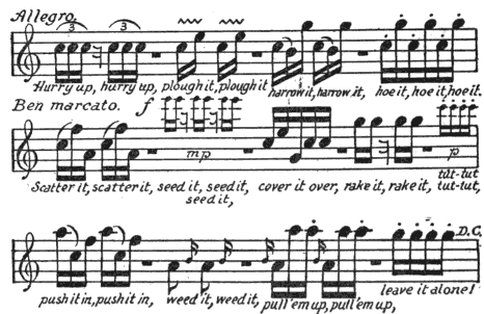 The song of the brown thrasher, as transcribed by Mathews
The song of the brown thrasher, as transcribed by Mathews[The Cornell Lab of Ornithology's recording of a brown thrasher is here]
Birds on Wires
While on the subject of birds and musical notation, here’s something strange and wonderful that a friend found on YouTube and sent along. I guarantee it will lift you up:
https://www.youtube.com/watch?v=LoM4ZZJ2UrMhttp://
___________________________________
…And Something New from Jerry Dennis and Glenn Wolff:
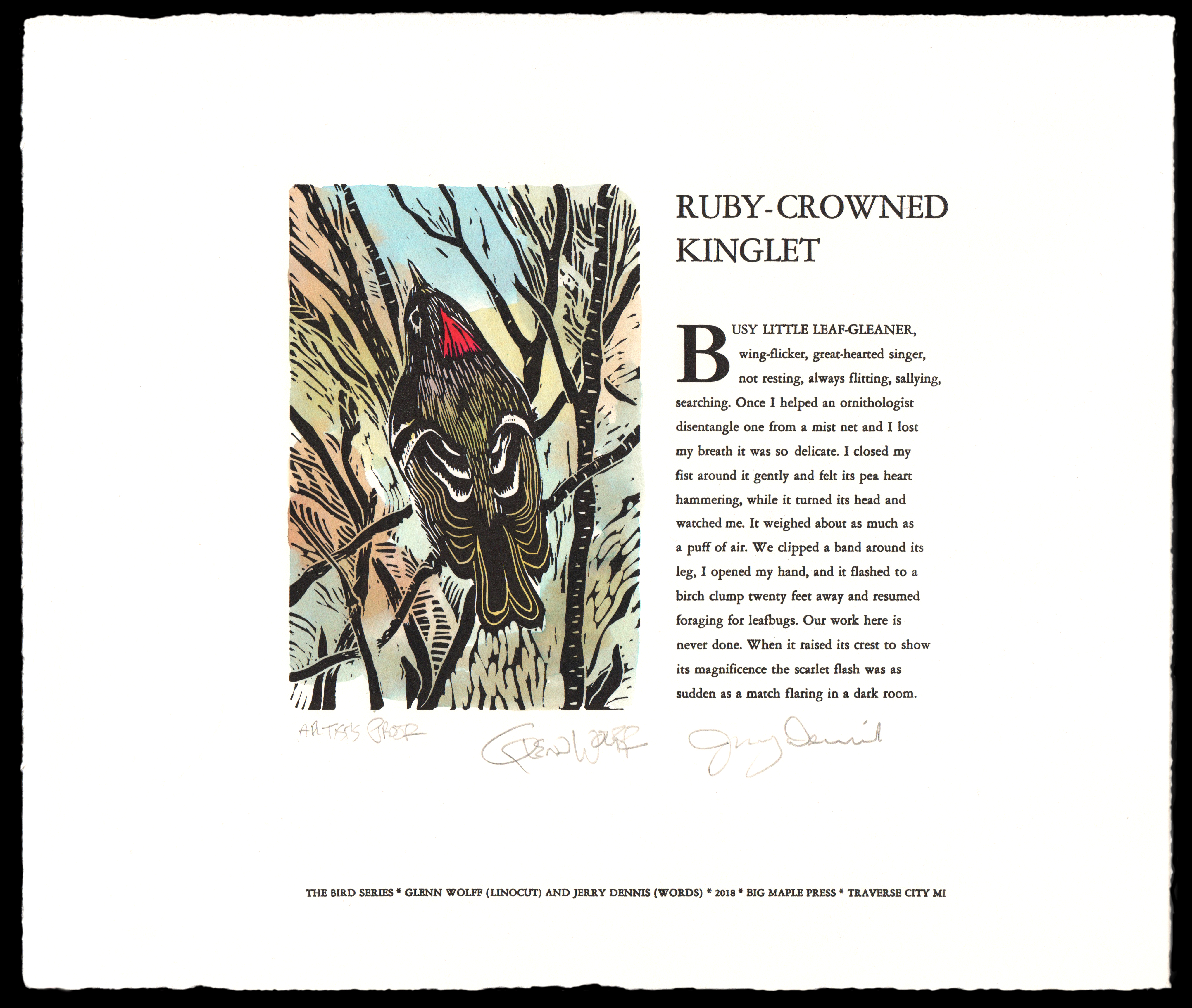
The new broadside from Jerry and Glenn—the first in their Bird Series. Learn more at www.bigmaplepress.com
SPRING ARRIVES!
Ah, the season of promise. Is it any wonder we grow impatient for it in March, when the last winter storms close roads and snap trees beneath their weight? We step outside hoping to hear the bassoon rumble of frogs mating in the neighbor’s pond—and instead are struck by a cold wind from the north and a rattling of sleet.
I remember a spring many years ago that arrived more slowly than most. It was 1979, the year that 32 feet of snow fell on the Keweenaw Peninsula and a succession of blizzards swept across the U.S. and Canada, shutting down cities from the Rockies to the East Coast. I was a student at Northern Michigan University in Marquette, and watched with astonishment as the temperature plummeted to 20 then 30 then 50 below zero. Lake Superior froze from shore to shore that year, and snow banks rose so high that pedestrians could touch the telephone wires.
By April everyone was eager for spring, but the wait became discouraging. I walked to school every day and noticed that the buds on the trees and shrubs remained tight as fists. The snow settled to a few feet of dirty crust, but would melt no further. The days stayed a cheerless 25 degrees, and the nights fell to the teens. The sky stayed dark and cloud-covered.
The last Saturday of the month, the opening day of trout season, I drove to a stretch of river I had discovered the previous summer. It was in a secret valley of cedars, and getting there required a long walk over ice-crusted snow with my unstrung fly rod in hand. When I reached the river it was flowing high, dark, and dangerous. I walked the bank, pretending to look for trout, but watching, in truth, for spring.
It arrived in the afternoon, when the clouds parted for a few minutes and an ice dam upstream burst, sending a knee-high wave of ice and slush surging toward me. The river rose two feet in five minutes and changed to the color of freshly stomped puddles. The sun broke free and birds began to sing. Hope surged through my veins and I hurried to string up my fly rod, attach a bead-head nymph, and roll some casts across the murky water. No trout showed themselves, but I didn’t expect them to. After a few minutes the sun disappeared behind clouds, the birds went silent, and my ears burned with cold again. But no matter— spring had arrived, with fanfare.
(First published in Jerry’s column, “Reflections,” in Michigan Blue Magazine)




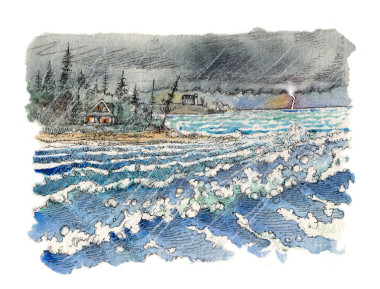
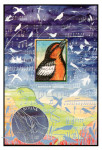
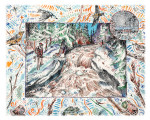
Leave a Comment